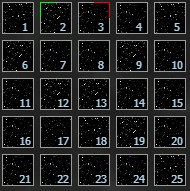Universe View
The universe is split up into 49 Galaxies in a ring pattern. The central galaxy has the richest resources, but will also be the most highly contested region of space. Resource density decreases the further the galaxy is from the centre.
Once you click in to view a galaxy, you will be presented with the galaxy view, showing all the sectors within that galaxy.
Each sector contains 4 planetary systems containing planets which are each given a unique coordinate.
- The first coordinate shows which galaxy you are in.
- The second coordinate shows which sector of the galaxy you are in.
- The third coordinate shows which system within the sector.
- The fourth coordinate shows which planet you are at.
All players start with their home planet which is given the coordinates 0.0.0.0 and which is invisible to every other player.
In order to travel to a new planet you will need to first create a fleet in your ship yard and add ships to it on your fleet page.
Once your fleet is ready to move the fleet page allows you to add the coordinates so if you wish to move to a new planet you would simply put in the 4 numbers that relate to that planet and hit move e.g. 1.1.1.1
See Travel Times for more informations about how many turns it will take to travel.
The navigation also displays the status of an area/planet by colour:
- Grey = uncolonised
- Green = you have a planet in the galaxy/sector/system
- Blue = an alliance member has a planet in the galaxy/sector/system
- Red = there is a hostile player in the galaxy/sector/system
It is possible for a whole area to be controlled by you/your alliance/hostiles, in which case all 4 corners will be the same colour.
Galaxy view
Within a galaxy all sectors are equal, there is no difference in resource density.
The number of sectors per galaxy is :
- 25 sectors into galaxy 1
- 6 sectors into galaxies 2 - 13
- 2 sectors into galaxies 14 - 25
Sector view
There are 4 systems per sectors.
System view
Systems in Galaxy 1 have 12 planets. Systems in other galaxies have 9 planets.
Table of info
| Galaxy | Total Sectors | Total Systems | Total Planets | Typical Abundance | Coords Range |
| 1 | 25 | 100 | 1200 | 75% - 100% | 1.1.1.1 - 1.25.4.12 |
| 2-13 | 72 | 288 | 2592 | 70% - 90% | 2.1.1.1 - 13.6.4.9 |
| 14-49 | 72 | 288 | 2592 | 65% - 90% | 14.1.1.1 - 49.2.4.9 |


 1.
1.  1.
1.  1
1